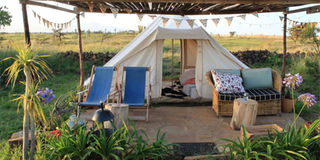Kenya’s new ‘glamping’ experience

The Touareg tent at Sieku Glamping. PHOTO I JAN FOX
What you need to know:
- The glampsite sits on a 33 acre farm in the south-eastern corner of Laikipia, about 235 km from Nairobi.
- Scattered across Sieku, too, are three bell tents and a Touareg tent, which altogether can sleep 12 to 14 people comfortably.
- On clear mornings and evenings you can also see Mount Warges, the largest mountain of the Mathews Range, and the rounded cliffs of Mount Ololokwe.
- To the south, Sieku also offers breath-taking views of Mount Kenya.
I first came across the term “glamping” – short for glamorous camping – in 2014.
A friend of mine had been pictured in the UK’s Daily Mail sipping a glass of champagne in a bell tent at the Glastonbury Festival. She was perched on the edge of a large double bed with plump pillows, beneath a tangle of fairy lights and surrounded by antique furniture.
This is largely how glamping has been popularised in recent years – as a comfortable alternative to pitching your own tent at music festivals across Europe and the United States. Though the word glamping is new, the concept of camping comfortably certainly isn’t.
TOUAREG TENT
In Kenya, luxury tented camps have been set up for wealthy travellers for over a century. But the modern-day equivalent of glamping has quickly evolved beyond expensive “glampsites” at music festivals. There are now glamping venues across the world, offering the experience of camping in the great outdoors, but with varying levels of home comforts.
Most venues include tipis, yurts or other forms of canvas tents, although the concept has now expanded to include log cabins, tree houses, teardrop campers and even gypsy wagons. Now, Kenya, too, has its very own glampsite. If you haven’t heard of it already, it’s called Sieku Glamping, and it does the modern-day glamping movement proud.
I’m always happy to pitch my tent whenever I travel, but I welcomed the idea of camping in comfort when I stayed at Sieku last weekend with a group of friends. The glampsite sits on a 33 acre farm in the south-eastern corner of Laikipia, about 235 km from Nairobi.
Beyond Timau there’s a turning to the left with a signpost for the Ngare Ndare Forest Trust, and from there it’s about 13 km to Sieku through Ethi town along a rough graded road. Over the last couple of decades, the plot of land that Sieku now occupies was abandoned and left fallow.
Most of the original red cedar tree cover had been cut down and the land was overgrazed, or used for wheat farming or charcoaling. But the site has been protected since 2013, allowing it to regenerate. Now there are small gardens scattered across the plot, with a wide range of indigenous trees, local succulents and flowering plants.
Scattered across Sieku, too, are three bell tents and a Touareg tent, which altogether can sleep 12 to 14 people comfortably. Each of these white canvas tents was imported from the UK, and is either four or five metres wide. Inside, the beds are covered by soft feathered duvets and pillows, and sit beside handmade shelves and side tables with small potted succulents.
PETANQUE COURT
The cosy décor is completed by the addition of kilim carpets, woven mats, sheepskin rugs, and of course – that glamping essential – a string of fairy lights. In front of each tent is a stone floor porch with deckchairs and a bamboo roof.
They all take advantage of incredible views north towards the Borana and Lewa conservancies, beyond the seasonal Sieku river, after which the plot is named. On clear mornings and evenings you can also see Mount Warges, the largest mountain of the Mathews Range, and the rounded cliffs of Mount Ololokwe. To the south, Sieku also offers breath-taking views of Mount Kenya.
Around the tents, and towards the bottom garden, there are picnic tables, viewing benches, a swing and a climbing frame, a fire pit, a petanque (boules) court, and a sand-floored “chill-out area” with a large hanging chair, a sofa, floor cushions and a couple of hammocks. So there are plenty of places to hide away with a book and to take in the view, and for kids to explore.
There are two communal toilets in amongst the tents and the vegetation, one of which is aptly named the “loo with a view”, as it overlooks large swathes of the Borana conservancy below. (Guests are encouraged to take their binoculars for extended visits). There’s an outdoor shower, too, with equally impressive views, and the water is mainly heated by the sun in black plastic containers.
At the top end of the plot is a large and tastefully furnished mess tent and a well-equipped kitchen, where guests can either cook for themselves or enjoy meals prepared by a chef if arranged in advance. Rob, Sieku’s owner, hopes over the next few months to finish the construction of a log cabin mess area by the bottom garden, as well as en-suite bathrooms and showers for each of the tents.
For those who don’t want to spend all day lounging around the glampsite, there’s plenty to do in the surrounding area, including walking, running and mountain biking around the site, swimming in the alluring blue pools of the Ngare Ndare Forest, and hiking through the nearby Mukogodo Forest.
A night at Sieku starts at just Sh5,000 for a double tent, which is great value. To book, email [email protected], visit their page on www.airbnb.com, or call 0718929022.
Jan Fox is a Director at iDC





